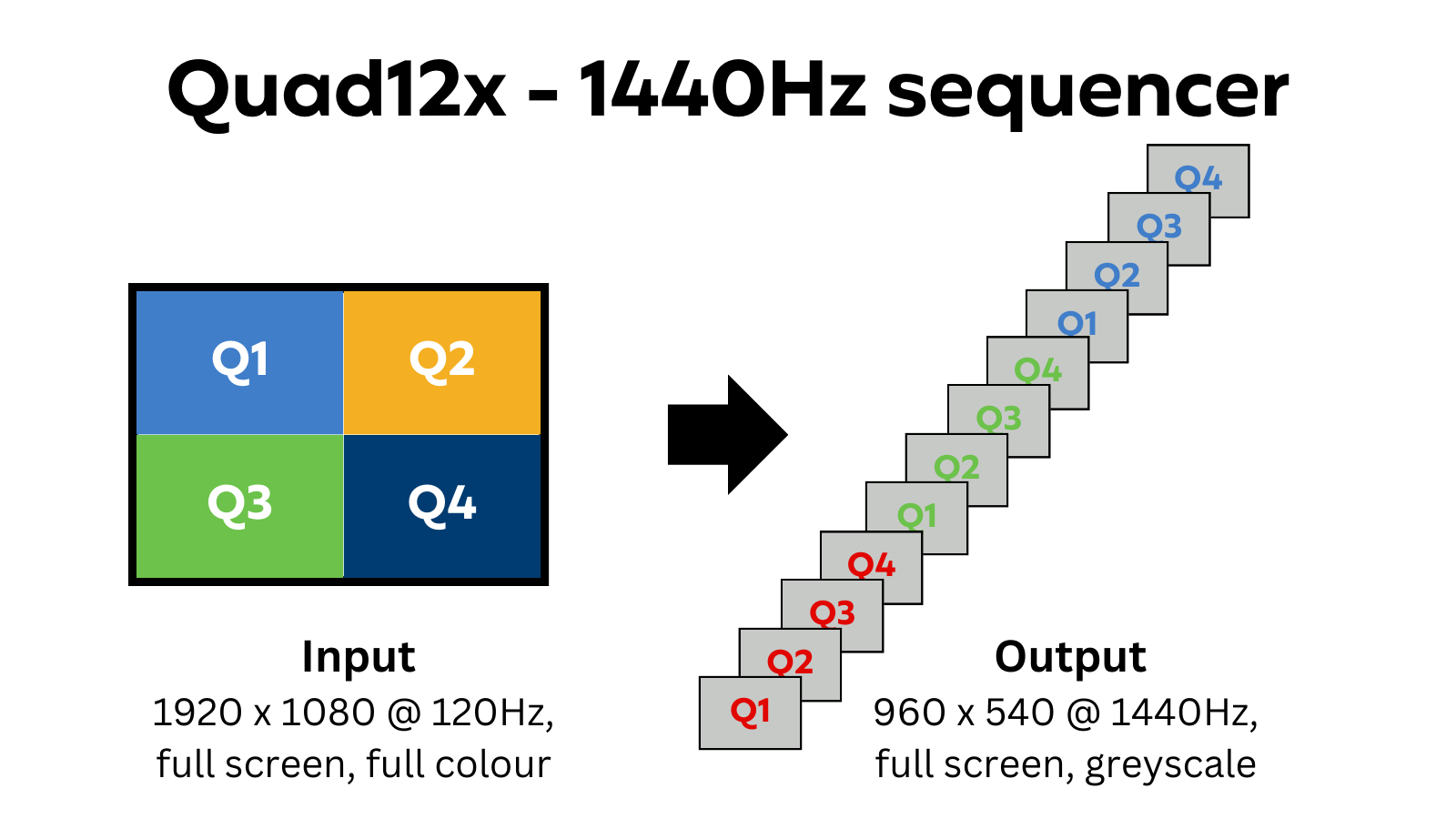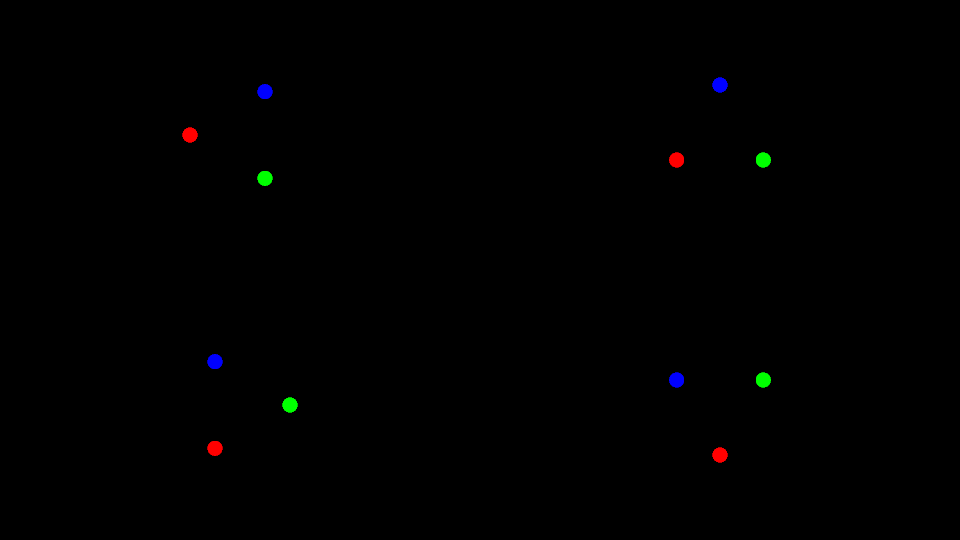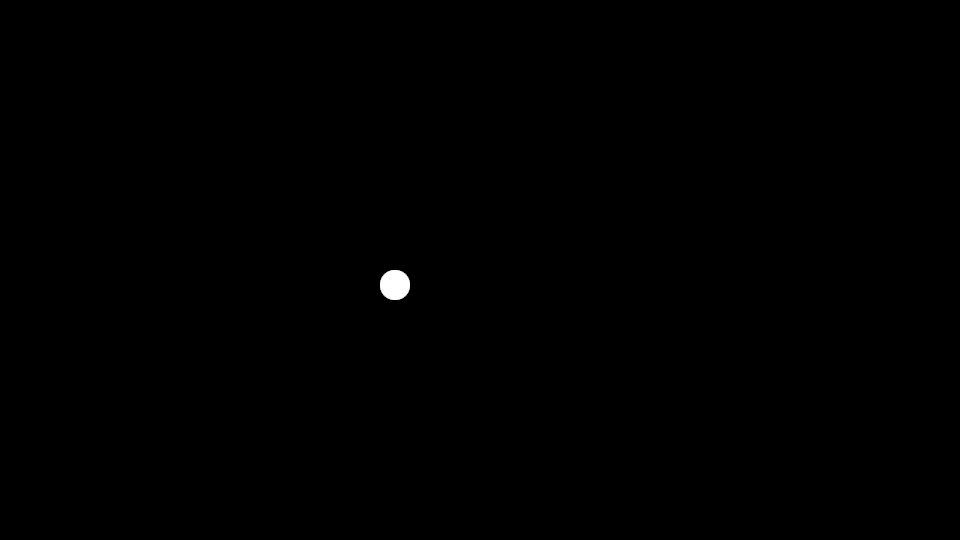This demo is a simple demonstration of the PROPixx’s 1440 Hz sequencer. We display twelve white dots around the center of the screen, cycling at a rate of 1440 Hz. The demo ends when a key is pressed.
Currently, there is no graphics card capable of drawing individual frames at this refresh rate. To achieve this rate, the PROPixx uses a “sequencer” to break up a single 1920 x 1080, 120 Hz RGB video signal into 12 multiple frames displayed in sequence. First, the 1920 x 1080 image is divided into four 960 x 540 images, or “quadrants”, which are magnified to full screen. Next, each 8-bit RGB color channel is converted to grayscale and displayed separately. The order of appearance is Q1 red, Q2 red, Q3 red, Q4 red, and then this order is repeated for G and B channels.

To create our stimuli, we determine target locations as if they were full resolution, full screen. The helper script convertToQuadrant reassigns and rescales the target positon to the correct quadrant. Depending on the frame, we draw our targets as either full red, full green or full blue.
A screen running in 120 Hz mode will display the twelve dots on the same frame, in the correct quadrant and with the correct color profile. Here is a demonstration, albeit slowed down:

A screen running in 120 Hz mode will display the twelve dots on the same frame, in the correct quadrant and with the correct color profile. Here is a demonstration, albeit slowed down.

The PROPixx in 1440 Hz mode will display the four quadrants in sequence, starting with red and repeating for green and blue. The image will be full screen, grayscale. Note: This animation is slowed down for demonstration purposes. At true 1440 Hz, the dots will seem to be ‘simultaneously’ visible in a ring.
function PPxDraw1440HzDots
%This function draws a circle of 12 dots refreshing at 1440Hz.
% First, we construct a single 1920 x 1080 RGB image, which is passed to
% the PROPixx. The sequencer breaks the image down and shows the quadrants
% and colour channels as 12 individual frames. These frames are 960 x 540
% resolution, shown full screen:
%_______________________________
%| | |
%| Q1 | Q2 |
%| | |
%|_____________|________________|
%| | |
%| Q3 | Q4 |
%| | |
%|_____________|________________|
%Quadrants are shown FULL SCREEN, GREYSCALE in the order:
% Quadrant 1 red channel
% Quadrant 2 red channel
% Quadrant 3 red channel
% Quadrant 4 red channel
% Quadrant 1 green channel
% Quadrant 2 green channel
% Quadrant 3 green channel
% Quadrant 4 green channel
% Quadrant 1 blue channel
% Quadrant 2 blue channel
% Quadrant 3 blue channel
% Quadrant 4 blue channel
%In this demo we draw dots as if they were full screen. The helper function
%'convertToQuadrant' reassigns the positon of the dot (based on full
%display) to the correct quadrant.
% 2020 Mar 18 lef written
% 2020 Mar 26 lef revised
%Check connection and open Datapixx if it's not open yet
isConnected = Datapixx('isReady');
if ~isConnected
Datapixx('Open');
end
Datapixx('SetPropixxDlpSequenceProgram', 5); %Set Propixx to 1440Hz refresh (also known as Quad12x)
Datapixx('RegWrRd'); %Push command to device register
%Open a display on the Propixx
AssertOpenGL;
KbName('UnifyKeyNames')
Screen('Preference', 'SkipSyncTests', 1);
screenID = max(Screen('Screens'));
[windowPtr,rect] = Screen('OpenWindow', screenID, 0);
%Set up some stimulus characteristics
dotRadius = 15;
targetRadius = 200;
center = [rect(3)/2, rect(4)/2];
%Let's define the 12 locations around a circle where we want to draw our
%stimuli
position = [-180:30:180];
locations = nan(12,2);
for k=1:12
angle = position(k);
locations(k, 1) = center(1) + targetRadius * cos(-angle*pi/180);
locations(k, 2) = center(2) + targetRadius * sin(-angle*pi/180);
end
%Start displaying dots
while 1
%DRAW RED
%Q1 red
quadrant = 1;
colour = [255,0,0];
position = locations(1,:);
[x,y] = convertToQuadrant(position, rect, quadrant);
Screen('FillOval', windowPtr, colour, [x-dotRadius, y-dotRadius, x+dotRadius, y+dotRadius]);
%Q2 red
quadrant = 2;
colour = [255,0,0];
position = locations(2,:);
[x,y] = convertToQuadrant(position, rect, quadrant);
Screen('FillOval', windowPtr, colour, [x-dotRadius, y-dotRadius, x+dotRadius, y+dotRadius]);
%Q3 red
quadrant = 3;
colour = [255,0,0];
position = locations(3,:);
[x,y] = convertToQuadrant(position, rect, quadrant);
Screen('FillOval', windowPtr, colour, [x-dotRadius, y-dotRadius, x+dotRadius, y+dotRadius]);
%Q4 red
quadrant = 4;
colour = [255,0,0];
position = locations(4,:);
[x,y] = convertToQuadrant(position, rect, quadrant);
Screen('FillOval', windowPtr, colour, [x-dotRadius, y-dotRadius, x+dotRadius, y+dotRadius]);
%DRAW GREEN
%Q1 green
quadrant = 1;
colour = [0,255,0];
position = locations(5,:);
[x,y] = convertToQuadrant(position, rect, quadrant);
Screen('FillOval', windowPtr, colour, [x-dotRadius, y-dotRadius, x+dotRadius, y+dotRadius]);
%Q2 green
quadrant = 2;
colour = [0,255,0];
position = locations(6,:);
[x,y] = convertToQuadrant(position, rect, quadrant);
Screen('FillOval', windowPtr, colour, [x-dotRadius, y-dotRadius, x+dotRadius, y+dotRadius]);
%Q3 green
quadrant = 3;
colour = [0,255,0];
position = locations(7,:);
[x,y] = convertToQuadrant(position, rect, quadrant);
Screen('FillOval', windowPtr, colour, [x-dotRadius, y-dotRadius, x+dotRadius, y+dotRadius]);
%Q4 green
quadrant = 4;
colour = [0,255,0];
position = locations(8,:);
[x,y] = convertToQuadrant(position, rect, quadrant);
Screen('FillOval', windowPtr, colour, [x-dotRadius, y-dotRadius, x+dotRadius, y+dotRadius]);
%DRAW BLUE
%Q1 blue
quadrant = 1;
colour = [0,0,255];
position = locations(9,:);
[x,y] = convertToQuadrant(position, rect, quadrant);
Screen('FillOval', windowPtr, colour, [x-dotRadius, y-dotRadius, x+dotRadius, y+dotRadius]);
%Q2 blue
quadrant = 2;
colour = [0,0,255];
position = locations(10,:);
[x,y] = convertToQuadrant(position, rect, quadrant);
Screen('FillOval', windowPtr, colour, [x-dotRadius, y-dotRadius, x+dotRadius, y+dotRadius]);
%Q3 blue
quadrant = 3;
colour = [0,0,255];
position = locations(11,:);
[x,y] = convertToQuadrant(position, rect, quadrant);
Screen('FillOval', windowPtr, colour, [x-dotRadius, y-dotRadius, x+dotRadius, y+dotRadius]);
%Q4 blue
quadrant = 4;
colour = [0,0,255];
position = locations(12,:);
[x,y] = convertToQuadrant(position, rect, quadrant);
Screen('FillOval', windowPtr, colour, [x-dotRadius, y-dotRadius, x+dotRadius, y+dotRadius]);
%Now that we have drawn content to all 12 frames, it is time to flip.
%The graphics card sends this as a single 1920 x 1080 image at 120 Hz,
%which the sequencer breaks down into the 12 frames, presented in the
%order they were drawn.
Screen('Flip',windowPtr);
%Keypress to exit
[keyIsDown, ~, ~, ~] = KbCheck;
if keyIsDown
break
end
end
Screen('Closeall');
Datapixx('SetPropixxDlpSequenceProgram', 0); %Revert to standard 120Hz refresh rate
Datapixx('RegWrRd');
Datapixx('Close');
end
function [x,y] = convertToQuadrant(position, displaySize, quad)
%This scales an x, y position into a specific quadrant of the screen
scale = 0.5;
switch quad
case 1; xOffset = 0; yOffset = 0;
case 2; xOffset = displaySize(3)/2; yOffset = 0;
case 3; xOffset = 0; yOffset = displaySize(4)/2;
case 4; xOffset = displaySize(3)/2; yOffset = displaySize(4)/2;
end
x = (position(1)*scale)+xOffset;
y = (position(2)*scale)+yOffset;
end